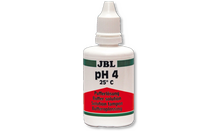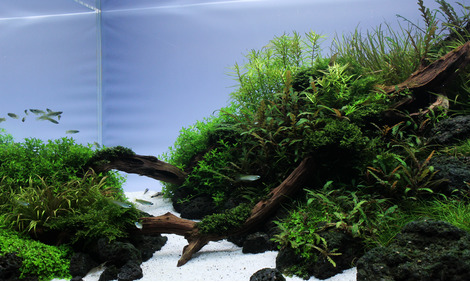Healthy fish thanks to ideal pH value
The pH value defines the acidity of the water. It needs to be constantly checked and adjusted as necessary to maintain the health of the fish and plants. The correct pH value depends on the fish stock of the aquarium. The wrong pH value can cause stress and diseases.
Technical information:
Precision solenoid valve.
Separate pH value + temperature sensors.
Modern graphic display.
Sensor check during each calibration.
Error diagnosis after failed calibration.
Permanent display: pH actual/set value, sensor voltage, temperature, calibration reminder in days/hours, valve status, precision of measurement.
Set point adjustment: freely selectable or automatic calculation by means of auto pH.
Automatic temperature compensation during measuring and calibration.
Hysteresis freely selectable (upper and lower deviation from switching point).
Password key lock.
Alarm function pH (alarm range).
Alarm function temperature (range and set point alarm).
Selectable valve status.
Language selection: D/BG/F/NL/I/DK/E/P.
Reset function.
Universal power unit suitable for all common mains voltages worldwide. Electrode to be separately purchased to make sure that user always gets a brand-new sensor. The electrode needs to be replaced about once a year.
JBL PROFLORA pH Control
Measurement and control computer to control the CO2/pH values in aquariums
PROFLORA pH-Control Touch
- Promotes plant growth and leads to lively fish: measurement and control computer for the high-precision calculation and control of the optimal pH value in aquariums
- Easy to mount and to operate: permanent wall mounting with mounting bar – removable. Measurement by means of separately available pH electrode (to be replaced about once a year, not included)
- Digital measurement and control technology: graphic display, direct user interface, separate sensors for pH value and temperature, precision solenoid valve to control the bubble count
- Automatic regulation: detection of the set and the actual pH value. Automatic calculation and supply of the required CO2 amount. Alarm function
- Package contents: computer ProFlora pH-Control incl. wall mount, power supply unit, temperature sensor, buffer solution pH 7/pH 4, storage/revitalisation solution, distilled water, carbonate hardness test set, calibration cuvettes, 4 year warranty
You may also be interested in
JBL PROFLORA pH Control
Properties
| Animal size: | For all animal sizes |
| Animal age group: | All aquarium fish |
| Colour: | black |
Electronic label / illuminant
| Mercury: | No |
| Dimmable: | No |
Technical Data
It is difficult to give a precise answer without information about the sensor, particularly the age of the sensor. Good sensors have deviations in the range from 0.02 to 0.05 pH levels when calibrating.
The input voltage differs for each electrode, as each electrode has its own individual properties. For the majority of our electrodes, it is between -30 and +30 mV at pH 7.
Both input voltages (pH 7 and pH 4) are important when assessing the quality of an electrode. The greater the difference between these two values, the better the electrode and the precision of the measurement and control. The differences should be over 140-150 mV.
The temperature sensor should always be used during calibration. The pH level varies according to temperature, so that it is always best to measure the pH level with temperature compensation.
When the electromagnetic valve in the controller is switched off, the pressure in the entire system from the cylinder to the pressure reducer and the tubes and to the electromagnetic valve persists. When the valve is opened, the pressure in the system escapes first and then the system continues to operate as usual.
You can decrease / prevent this by reducing the operating pressure in your pressure reducer. In our new pressure reducers, this can be done with an Allen wrench under the black cover top.
The cause can probably be fixed quite easily. The protective cap of the pH sensor needs to be removed before insertion into the aquarium / before the calibration, to carry out control / calibration correctly. The protective cap serves as storage and “reactivation” of the sensor with the storage liquid. It has to be removed for use inside the aquarium and during the calibration because no water from outside can pass through.
If the controller still displays an error, even after the removal of the protective cap, please read the FAQ with the several error messages in detail.
If the pH value is subject to greater fluctuation, this indicates a source of interference through another electronic device. Ballasts in light bars, for instance, create an electromagnetic field if they are not shielded against interference. This can disturb the sensitive sensor. When you unplug the power plug from the outlet the pH value suddenly stabilises. You can carry this process out with every electrical device in the aquarium to find the cause.
Through the use of separated power-carrying cables further disturbances can be avoided. Separating electrical circuits may also prove to be an advantage. The JBL pH controllers are manufactured and tested in accordance with DIN EN 55014-2 and do not interfere with other technical items. Thus wearers of pacemakers are not exposed to any danger through the JBL pH Control.
Should another technical item disturb your pH control, then it is not electromagnetically shielded according to this technical standard.
If the error still persists try removing the temperature sensor from the controller. If the value now remains stable, the temperature sensor may be defective.
The message INSTAB indicates: instable sensor voltage: the sensor tip is dirty, the electrolyte has leaked from the sensor, the sensor tip is damaged.
Remedy: Clean the sensor head (see the respective instruction), put the sensor into the storage solution for 24 hours and repeat the calibration. If this does not work the sensor is defective and should be replaced.
The message OFFSET indicates: sensor voltage at pH 7.00 is outside the limit value, the sensor is too old, the cable is defective or no sensor is connected.
Remedy: Check the sensor cable for any signs of damage and repeat the calibration. If this does not work, replace the sensor and calibrate again.
The connection is a BNC connector.
This message indicates that the potential difference per full pH unit is smaller than 35 mV. The pH sensor is either too old, defective or was accidentally calibrated twice with the same buffer solution.
Remedy: Repeat the calibration and take care to use the buffer solution correctly. If this does not work, connect a new sensor and calibrate again.
No, that refers to the pH sensor, which is in a casing that is filled with a storage solution. The pH sensor must be taken out of this casing before calibrating by removing the screw cap. The sensor must also be submerged in the tank water without this casing (but with the storage solution.
The pH sensor transmits a voltage to the measuring device, which convert the voltage into the pH value.
This voltage does NOT remain constant throughout the service life of the sensor! It needs to be calibrated regularly. The device is thus informed about the age-related change in voltage and can display reliable values again.
The calibration takes place at pH 7 and pH 4.
At pH 7 a new sensor transmits a voltage of 0 mV (+/- a few mV) to the measuring device. The more the voltage at pH 7 deviates from 0, the older the sensor is. The deviation can occur at + or -. At a deviation of more than +40 or -40 mV the device rejects the sensor.
The error message OFFSET appears.
NOTE: The same error message appears if you accidentally begin to calibrate at 4!!
At pH 4 the sensor transmits a voltage of about +186 mV (when 7 is at 0 mV). This means that between the single steps (4-5; 5-6 and 6-7) there is in each case a difference of about 62 mV. The smaller this difference, the older the sensor. With differences below 30 mV the device rejects the sensor.
The error message DELTAV appears.
NOTE: The same error message also appears, when you accidentally calibrate twice at 7!!
IMPORTANT: Rejected sensors can often be brought “back into operation” if you soak them intensively in storage solutions (for several days)!
The dimensions of the JBL pH Control 12 V are: W x H x D: 20 cm x 10 cm x 5 cm. Incl. the connections, the height is 11.5 cm.
The connecting space under the controller should be an additional 4-5 cm for trouble-free installation.
Although the controller is not designed for building it into a wall, it can be mounted on a trim rail, which in turn can be mounted on a wall. This increases the depth to 5.5 cm.
A display of XX means that the pH controller isn’t receiving any input value. This may be due to the following:
1) There is no contact in the plug, perhaps caused by a slightly corrosive coating. Please check the contact points of the plug.
2) The temperature sensor is defective. In this case, please contact JBL.
Note: The JBL pH Control 12 V can also be operated without a temperature sensor. In this case, the controller adjusts itself to a water temperature of 25 °C.
A slight excess pressure develops between the pressure reducer and the solenoid valve when the solenoid valve is turned off. It then escapes all at once when the valve is opened. This can be prevented by doing the following:
1) Select the shortest possible length for the hose connection between the pressure reducer and JBL pH Control 12 V.
2) Reduce the preset operating pressure of your pressure reducer.
CO2 systems operated with a pH controller do not need an additional night time switch-off, as they do not turn on the CO2 supply in the absence of CO2 consumption or do so less frequently when CO2 degassing occurs at the water surface. That is why the control units do not need a timer.
If you would like to have the CO2 turned off completely at night, you will need a second solenoid valve that is connected to the timer of the lighting, which would need to be installed between the pressure reducer and the pH controller.
-
Download
JBL ProFlora pH Control
-
Download
JBL ProFlora pH Control-Produkttest
-
Download
JBL ProFlora pH Control AQUACHARTS Aquaristik Test
-
Download
JBL ProFlora pH Control- Erfahrungsbericht
-
Download
JBL ProFlora pH Control-Erfahrungsbericht
-
Download
safety instruction for technical devices
-
Filename:JBL_Sicherheitshinweis_fuer_Technische_Geraete.pdf
-
Instructions
Additional product information and downloads
safety instructions
Reviews
0 Reviews
Show another review in another languages
A review in another language
Kann ich jeden nur empfehlen der co2 und Ph Control in einem Haben Möchte.



























